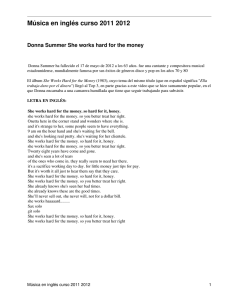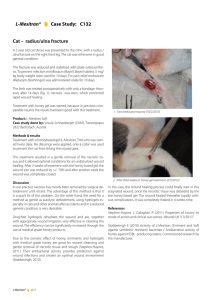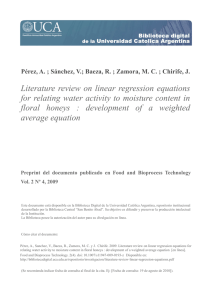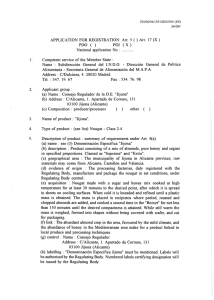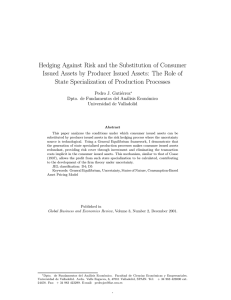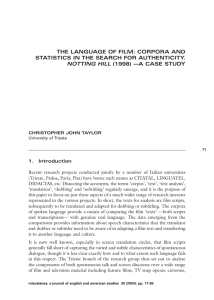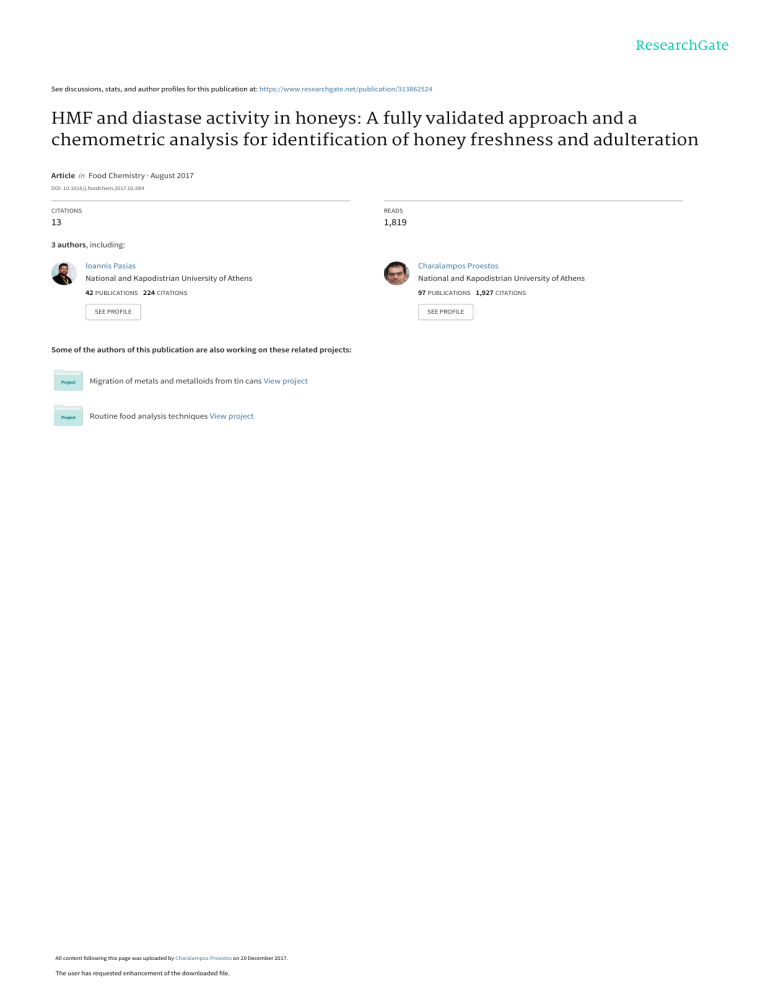
See discussions, stats, and author profiles for this publication at: https://www.researchgate.net/publication/313862524 HMF and diastase activity in honeys: A fully validated approach and a chemometric analysis for identification of honey freshness and adulteration Article in Food Chemistry · August 2017 DOI: 10.1016/j.foodchem.2017.02.084 CITATIONS READS 13 1,819 3 authors, including: Ioannis Pasias Charalampos Proestos National and Kapodistrian University of Athens National and Kapodistrian University of Athens 42 PUBLICATIONS 224 CITATIONS 97 PUBLICATIONS 1,927 CITATIONS SEE PROFILE Some of the authors of this publication are also working on these related projects: Migration of metals and metalloids from tin cans View project Routine food analysis techniques View project All content following this page was uploaded by Charalampos Proestos on 20 December 2017. The user has requested enhancement of the downloaded file. SEE PROFILE Food Chemistry 229 (2017) 425–431 Contents lists available at ScienceDirect Food Chemistry journal homepage: www.elsevier.com/locate/foodchem Analytical Methods HMF and diastase activity in honeys: A fully validated approach and a chemometric analysis for identification of honey freshness and adulteration Ioannis N. Pasias a, Ioannis K. Kiriakou a, Charalampos Proestos b,⇑ a b Chemical Laboratory of Lamia, Karaiskaki 85, Lamia 35100, Greece National and Kapodistrian University of Athens, Department of Chemistry, Food Chemistry Laboratory, Panepistimiopolis Zografou, 15771 Athens, Greece a r t i c l e i n f o Article history: Received 29 June 2016 Received in revised form 17 November 2016 Accepted 17 February 2017 Available online 22 February 2017 Keywords: Diastase activity HMF Uncertainty Honey PCA Cluster analysis Chemometrics a b s t r a c t A fully validated approach for the determination of diastase activity and hydroxymethylfurfural content in honeys were presented in accordance with the official methods. Methods were performed in real honey sample analysis and due to the vast number of collected data sets reliable conclusions about the correlation between the composition and the quality criteria were exported. The limits of detection and quantification were calculated. Accuracy, precision and uncertainty were estimated for the first time in the kinetic and spectrometric techniques using the certified reference material and the determined values were in good accordance with the certified values. PCA and cluster analysis were performed in order to examine the correlation among the artificial feeding of honeybees with carbohydrate supplements and the chemical composition and properties of the honey. Diastase activity, sucrose content and hydroxymethylfurfural content were easily differentiated and these parameters were used for indication of the adulteration of the honey. Ó 2017 Elsevier Ltd. All rights reserved. 1. Introduction During the last few years, honey consumption has increased since it is a natural product composed of sugars, enzymes, amino acids, organic acids, carotenoids, vitamins, minerals, and aromatic substances. It has an important antioxidant activity and is usually used as a food additive in many beverages and foodstuffs. The chemical composition of honey is perfectly described by Silva et al. in their excellent review (Silva, Gauche, Gonzaga, Costa, & Fett, 2016). The rapid growth in honey production has made the sector important to the economy of many developing countries, whereas there is an increased concern for public health since honey undergoes many changes in its composition during storage and processing (Barra, Ponce-Díaz, & Venegas-Gallegos, 2010; Tornuk et al., 2013). Furthermore, the bad agricultural practice and the small amounts of honey production have provided a heightened interest in its adulteration (Wang, Juliani, Simon, & Ho, 2009). The detection of the adulteration of honey is very difficult and modern analytical techniques are required, such as liquid chromatography coupled to isotope ratio mass spectrometry, elemental ⇑ Corresponding author. E-mail address: iharpro@chem.uoa.gr (C. Proestos). http://dx.doi.org/10.1016/j.foodchem.2017.02.084 0308-8146/Ó 2017 Elsevier Ltd. All rights reserved. analyzer-isotope ratio mass spectrometry and gas chromatography coupled to mass spectrometry (Cabañero, Recio, & Rupérez, 2006; Luo et al., 2016; Padovan, De Jong, Rodrigues, & Marchini, 2003). Due to the availability and variety of different analytical methods and national regulation European Commission has adopted quality assurance systems and specifically by applying methods validated and according to common procedures and performance criteria. In Council Directive, 2001/110/EC all quality criteria of honey are described concerning the quality control of honey, the rules on the conditions for the production and marketing of honey, and the food-labelling rules (Council Directive, 2001/110/EC; Puscas, Hosu, & Cimpoiu, 2013). The analytical results generated by laboratories approved for the official control of honeys must be accurate and precise with low detection limits and costs in short analysis times. In the field of honey chemical analysis there are some parameters that must be determined such as, conductivity, sugar content, hydroxymethylfurfural (HMF) content, diastase activity, acidity, moisture and pollen type. These methods are described in Codex Alimentarius, AOAC and other standards but in routine analysis are difficult to validate (AOAC 958.09-1977, 2010; AOAC 980.23, 1983, 1990; Codex Standard, 12-1981). Numerous studies have been carried out on chemical composition of different pollen type honeys and from different regions, based on these methods (Silva et al., 426 I.N. Pasias et al. / Food Chemistry 229 (2017) 425–431 2016). Among these parameters HMF, diastase activity and sugar content are the most important for the quality control of different honey samples. HMF is a furanic compound which is formed as an intermediate in the Maillard reaction from the direct dehydration of sugars under acidic conditions (caramelisation) during thermal treatments applied to foods (Ames, 1992; Kroh, 1994). The Codex Alimentarius of the World Health Organization and the European Union have established a maximum quality level for the 5-HMF content in honey (40 mg kg1) (Alinorm 01/25, 2001; Council Directive, 2001/110/EC). Diastase is one of the major enzymes found in honey. Diastase activity and HMF content are well used as criteria to assess the quality of the product (Thrasyvoulou, 1986). Furthermore, according to the European Union, when placed on the market as honey or used in any product intended for human consumption, honey must meet the following sugar composition criteria: (a) for blossom honey the sum of fructose and glucose should not be less than 60%, whereas the sucrose content should not be higher that 5% and (b) for honeydew honey the sum of fructose and glucose should not be less than 45%, whereas the sucrose content should not be higher that 5%. The main difficulty in routine analysis is the full validation of a method for the determination of diastase activity and HMF content. The fact that these methods are official does not guarantee that the laboratories can perform the analysis correctly. The aim of this study is to describe for the first time an approach for the development of fully validated methods for these parameters. To the best of our knowledge there are no similar studies concerning the same topic. The accuracy, the precision and the uncertainty of these methods were calculated for the first time. Different blossom and honeydew samples were analyzed and the collected data were statistically edited, and reliable conclusions about the correlation between the composition and the quality criteria were exported. Principal component analysis and cluster analysis were performed in order to examine the correlation among the artificial feeding with carbohydrate supplements of honeybees, the freshness of the honey with HMF content and diastase activity. 2. Materials and methods 2.1. Honey samples Thirty nine different honey samples (25 flower type honey and 14 honeydew honey samples) were collected from local experienced beekeepers in Lamia Greece, (from 2015 to 2016). Samples were stored at room temperature until analysis. All honey samples were characterized on the basis of melissopalynological characterization according to their specific botanical variety (Louveaux, Maurizio, & Vorwohl, 1978). 2.2. HMF determination The HMF content determination was based on the official AOAC method (AOAC official method 980.23, 1983). Five grams of honey were dissolved in 25 ml of water, transferred quantitatively into a 50 ml volumetric flask, added by 0.5 ml of Carrez solution I and 0.5 ml of Carrez II and make up to 50 ml with water. The solution was filtered through paper rejecting the first 10 ml of the filtrate. Aliquots of 5 ml were put in two test tubes; 5 ml of distilled water were added to one tube (sample solution); 5 ml of sodium bisulphite solution 0.2% were added to the second (reference solution). The absorbance of the solutions at 284 and 336 nm was determined using a HACH LANGE DR 5000 UV–visible spectrometer. The HMF content was calculated by the equation (1): HMF ðmg=kgÞ ¼ ðA284 Þ ðA336 Þ 149:7; ð1Þ where A284: the absorbance at 284 nm A336: the absorbance at 336 nm 149.7: a factor calculated by the molecular weight of HMF and the mass of the sample. 2.3. Diastase activity Diastase activity was determined using 10 g of honey weighted a 50 mL beaker and 5 mL of acetate buffer were added, together with 20 mL of water. When the sample was completely dissolved 3 mL of sodium chloride 0.5 M were added and the solution was diluted to 50 mL with water. Moreover, a starch solution was standardized using an iodine solution. Both solutions were warmed at 40 °C. 5 mL of starch solution were added into 10 mL of honey solution and start stop-watch. An aliquot was taken every 5 min and was added to 10 mL of iodine solution. The absorbance was recorded and a calibration curve was obtained. According to the official AOAC method the number 300 was divided by the time needed to reach the absorbance value of 0.235 and expressed as DN or diastase number (AOAC 958.09-1977, 2010; Bodganov, Martin, & Lüllmann, 1997). 2.4. Sugar content and conductivity measurement The sugar content was based on the Lane Enyon method, and the estimation of the accuracy was also calculated by the certified reference material FAPAS T2830QC. The classical, official LaneEynon method for the determination of the total sugar content is based on a copper reduction method before and after inversion (AOAC, 1980). The results of the sugar content are only presented for comparison reasons. The conductivity was measured in a 20% (w/v) honey solution diluted with ultra-pure water. 2.5. Method validation The difficulty in methods such as diastase activity is to perform an accurate and precise analysis. For this reason the certified reference material FAPAS T2830QC, Fera Science Ltd was used in order to calculate the precision, the accuracy and the uncertainty of the proposed methods. The instrumental limits of detection (LOD (mg L1)) and of quantification (LOQ) were calculated. In order to determine the composition of a honey sample correctly the proposed LODs and LOQs should be less than one tenth and less than one fifth, respectively, of the maximum level in Regulation (EC) 2001/110/EC (Council Directive, 2001/110/EC). Precision under repeatability and reproducibility conditions were also estimated. As method’s precision performance criteria, the HORRATr were used, meaning the observed relative standard deviation (%RSDr) under repeatability conditions divided by the RSDr value estimated from the Horwitz equation (Thompson, 2000) using the assumption r = 0.66R, as well as the HORRATR values, meaning the observed RSDR value under reproducibility divided by the RSDR value calculated from the Horwitz equation. The HORRATr and HORRATR values should be less than two to perform a precise analysis. Furthermore, the accuracy of measurements was also assessed through the recovery as calculated by the multiple analysis of the certified reference material FAPAS T2830QC. Recovery data are only acceptable when they are within ±20% of the certified value (European Commission, 2002). Internal quality control charts (IQCs) were also constructed in order to monitor whether results are reliable enough to be released. The objective of IQCs is the elongation of method validation: continuously checking the accuracy of analytical data obtained from day to day in the laboratory. The analytical system is under control if no more than 5% of the measured values exceed 427 I.N. Pasias et al. / Food Chemistry 229 (2017) 425–431 the warning limits and none of them the action or control limits (Pasias, Papageorgiou, Thomaidis, & Proestos, 2012; Psoma, Pasias, Rousis, Barkonikos, & Thomaidis, 2014; Raptopoulou, Pasias, Thomaidis, & Proestos, 2014; Taverniers, De Loose, & Van Bockstaele, 2004). The uncertainty of the method was also calculated based on the Eurachem/Citac Guidelines. For most purposes in analytical chemistry, an expanded uncertainty U should be used. The expanded uncertainty provides an interval within which the value of the analyte concentration is believed to lie within a higher level of confidence. U is obtained by multiplying uc (y), the combined standard uncertainty, by a coverage factor k. The combined uncertainty uc (y) was calculated from the summary squared of several independent parameters as (a) the mass uncertainty; (b) the stock standard solutions; (c) the volume uncertainty; (d) the calibration uncertainty; (e) the bias uncertainty; and (f) the random errors uncertainty, following the rules of Eurachem/Citac Guidelines (Eurachem, 2000). 2.6. Statistical analysis Statistical analysis was performed with SPSS version 20.0 program. Different chemometric statistical analysis, such as principal component analysis and cluster analysis were performed in order to examine the correlation among the artificial feeding of honeybees with carbohydrate supplements and several chemical parameters of the honey. Whenever the content of any analyte was lower than the LOD it was replaced by LOD/2. 3. Results and discussion 3.1. The results of method validation For the determination of HMF content, quantification was performed using the certified reference material FAPAS T2830QC with certified value 40.86 ± 5.04, in order to avoid the matrix interferences. Different masses of the certified reference material were weighted and a calibration curve plotting the absorbance of the sample against reference at 284 and 336 nm versus analyte content in lg and typical linear correlation of R2 0.998 was obtained. The methods LOD and LOQ were determined by the standard deviation of the intercept of the calibration curve and were equal to 2.4 and 7.2 mg/kg. The calculated LOD was lower than the 1/10 of the maximum permissible level of 40 mg/kg and the LOQ was lower than the 1/5 of the maximum permissible as presented in Regulation (EC) No 110/2001 and in Codex Alimentarius (Codex Standard, 12-1981; Council Directive, 2001/110/EC). Table 1 Chemical composition of different honey type samples. Honey type Blossom Blossom Honeydew Blossom Blossom Blossom Honeydew Blossom Blossom Blossom Blossom Blossom Blossom Honeydew Blossom Blossom Blossom Blossom Honeydew Honeydew Honeydew Honeydew Blossom Blossom Blossom Honeydew Honeydew Blossom Blossom Honeydew Honeydew Blossom Blossom Blossom Blossom Honeydew Blossom Honeydew Honeydew Min-Max/Mean Min-Max/Mean * Sample coded as Palynological Characterization B1* Multifloral B2 Multifloral * HD1 Abies B3 Multifloral B4 Citrus B5 Strawberry HD2 Abies B6 Erica B7 Multifloral B8 Multifloral B9 Multifloral B10 Multifloral B11 Multifloral HD3* Pine B12* Multifloral B13 Multifloral B14 Multifloral B15 Multifloral HD4 Abies HD5 Abies HD6 Abies HD7* Pine B16 Cotton B17 Cotton * B18 Erica * HD8 Pine HD9 Pine B19 Citrus B20 Multifloral HD10 Pine HD11 Abies B21 Multifloral B22 Erica B23 Multifloral B24 Multifloral HD12 Abies B25 Multifloral HD13 Abies HD14 Abies value for honeydew honey value for blossom honey Honey samples artificially fed. HMF (mg/kg) Diastase activity (DN) Glycose + fructose content (% w/w) Sucrose content (%w/w) Conductivity (mS/cm) <2.4 <2.4 4.0 <2.4 26 <2.4 <2.4 7.1 22 51 18 <2.4 21 <2.4 10 6.0 6.5 <2.4 <2.4 <2.4 <2.4 <2.4 <2.4 16 <2.4 <2.4 3.9 2.5 6.3 <2.4 <2.4 <2.4 38 4.0 11 <2.4 <2.4 <2.4 <2.4 <2.4–4.0/2.4 <2.4–51/7.6 7.0 12 12 15 8.0 15 14 12 9.1 12 10 12 10 12 10 14 12 21 12 12 12 14 22 20 10 10 12 8.5 13 15 14 13 12 12 9.5 8.1 14 9.1 11 8.1–15.0/11.9 7.0–22.0/13.6 67 57 60 68 50 60 48 45 51 50 51 39 59 55 36 41 56 71 64 54 54 61 68 74 67 60 62 71 62 55 55 63 67 68 64 58 67 49 53 48–74/58 36–74/63 19 <0.5 15 1.2 1.4 <0.5 <0.5 <0.5 <0.5 <0.5 1.5 <0.5 2.0 4.1 5.2 2.2 4.1 0.7 1.2 0.7 0.5 9.0 1.0 <0.5 3.4 4.3 1.1 0.7 1.0 1.2 1.2 1.6 0.6 0.6 <0.5 <0.5 <0.5 0.6 <0.5 <0.5–15/2.9 <0.5–19/1.5 0.68 0.70 1.17 0.82 0.30 0.70 1.23 0.61 0.62 0.33 0.57 0.70 0.42 0.98 0.20 0.40 0.50 0.30 1.13 1.20 1.13 0.96 0.32 0.33 0.76 0.80 0.90 0.66 0.45 1.17 1.30 0.30 1.50 0.80 0.72 1.22 0.75 1.80 1.10 0.8–1.8/1.2 0.8–1.5/0.6 428 I.N. Pasias et al. / Food Chemistry 229 (2017) 425–431 Precision experiments were carried out and the relative standard deviation (%RSD) values achieved from three different concentration levels measured six times under repeatability conditions and six times at two different days under reproducibility conditions, were lower than 10% for all different concentration levels. The HORRATr and HORRATR values achieved from these different concentration levels, ranged from 0.24 to 0.36. These values were lower than the crucial value of two, and the method is ‘fitfor-purpose’. For accuracy estimation the certified reference material FAPAS T2830QC with certified value 40.86 ± 5.04 was analyzed 6 times in two different days by two different analysts (n = 12) and the recovery was found equal to 101.7 ± 4.4. The recovery data are within ±12% of the target value, as provided by the certification of the reference material and for this reason the method was again considered as ‘‘fit for purpose”. The uncertainty of the method was also calculated based on the Eurachem/Citac Guidelines. In practice, the uncertainty of the results in this study arose from many possible sources, including matrix effects and interferences, environmental conditions, uncertainties of masses and volumetric equipment, reference values, approximations and assumptions incorporated in the measurement method and procedure, and random variation. The combined uncertainty uc (y) was calculated from the summary squared of several independent parameters such as (a) the mass uncertainty; (b) the volume uncertainty; (c) the calibration uncertainty; (d) the bias uncertainty, as estimated by the recovery tests and through the comparison of the calculated recoveries and the theoretical ones provided by the certification of the reference material, and (e) the precision uncertainty, as estimated by the % RSDR values for the three different concentration levels under reproducibility conditions. The choice of the factor k is based on the level of confidence desired. For an approximate level of confidence of 95%, k is 2. The calculated expanded uncertainties were found equal to 21.0, 11.3 and 9.78% of the content of HMF in mg/kg for the LOQ, the centroid of the calibration curve, and the maximum permissible value, respectively. The validation of the diastase activity method is of vast importance, since the methods reported in the literature are not fully validated and there is a great variance among the determined values provided by different laboratories even if they use the same official method. In this work, the certified reference material FAPAS T2830QC with a certified reference value of 9.76 ± 3.34 DN (diastase number) was used in order to estimate the accuracy and the precision of the method. The calibration curve was achieved by plotting the absorbance of the KI after the addition of a known amount of properly prepared honey sample solution in different periods of time versus the time of the reaction of diastase with starch and typical linear correlation of R2 0.99 was obtained. The LOD and the LOQ of the method was calculated by the standard deviation of ten blank determinations and found equal to 2.6 and 7.2 DN, respectively. Precision experiments were carried out and the relative standard deviation (%RSD) values achieved from the multiple analysis of the certified reference material (n = 6) under repeatability and reproducibility conditions, were lower than 12%. For accuracy estimation the certified reference material FAPAS T2830QC with certified value 9.76 ± 3.34 DN was analyzed 6 times in two different days by two different analysts (n = 12) and the recovery was found equal to 90.0 ± 9.3. The recovery data are within ±34% of the target value, as provided by the certification of the reference material and for this reason the method was again considered as ‘‘fit for purpose”. The combined uncertainty uc (y) was also calculated as for the HMF method, since the same parameters contributed to the uncertainty. The uncertainty of the method was found equal to 23.9% of the diastase activity calculated in DN units. 3.2. Determination of HMF content and diastase activity in honey samples The developed and fully validated method was applied for determination of HMF content and diastase activity in honey samples. Thirty nine different honey samples (25 flower type honey and 14 honeydew honey samples) were collected from local Fig. 1. Principal component analysis plot showing the factor loadings of different honey samples (Varimax normalized). I.N. Pasias et al. / Food Chemistry 229 (2017) 425–431 experienced beekeepers in Lamia, Greece (from 2015 to 2016). Samples were stored at room temperature until analysis. All honey samples were characterized on the basis of melissopalynological characterization. The results are provided in Table 1. Other physicochemical parameters, such as electrical conductivity, and sugar content are also given for comparison reasons. The results showed that the HMF content is lower in honeydew honeys samples than in blossom honey samples. The main reason of this observation is that blossom honey is often heated in order to prevent the crystallization of honey and the inhibition of microbial growth. On the contrary, honeydew honey has low content of sugars and the crystallization is rarely observed. However, thermal treatment has also negative effects on the diastase activity. On the other hand, diastase activity was higher in blossom honey samples, as expected. In general, the contents of HMF in Greek type honeys were much 429 lower than other found in the literature, such as Tualang honey, Gelam honey, Manuka honey, Eucaliptus type honey, Rubus type honey, Echium type honey, Leotondon type honey and other, whereas diastase activity was similar (Gomes, Dias, Moreira, Rodrigues, & Estevinho, 2010; Khalil, Sulaiman, & Gan, 2010; Rizelio et al., 2012). A full kinetic study of HMF formation and diastase activity has been recently presented by Khan, Nanda, Bhat, and Khan (2015) and Tosi, Martinet, Ortega, Lucero, and Re (2008). On both works it was proved that the increase of the temperature has an effect on the content of HMF and diastase activity, especially for temperature over 60 °C. However, there is an inconvenience about the enhancement of diastase activity during the isothermal heating steps. In Khan et al. work (2015) the diastase activity was further decreased with the time of isothermal treatment, whereas in Tosi Fig. 2. Dendrogram of the cluster analysis of the samples using Ward’s method/Euclidean distances. 430 I.N. Pasias et al. / Food Chemistry 229 (2017) 425–431 Fig. 3. Dendrogram of the cluster analysis of the chemical composition of different honey type samples using Ward’s method/Euclidean distances, where diastase explains the diastase activity, SUC the sucrose content, HMF the HMF content and GLY +FRU the sum of fructose and glucose content. et al. work (2008) diastase activity remained constant. In general, HMF and diastase activity were used as freshness indicators and are considered among the most important parameters on the prediction of the quality of honey samples (Thrasyvoulou, 1986). However, as Thrasyvoulou (1986) proved, they cannot be considered as criteria for detecting overheated honeys. In general, using HMF and diastase as criteria to assess the quality of the product, some honey samples could be regarded as industrial honey although they are fresh, unheated and naturally pure. For example citrus honey has in general low diastase activity (Table 1) and for this reason the European Commission has set a different limit for this type of honey (Bonvehi & Coll, 1995). In general, cotton type honey seems to have high diastase content, whereas citrus and thyme type honey seem to have the lower (Table 1). The differences in diastase activity in honeys may vary depending on the age of the bees, the nectar collection period, the physiological period of the colony, the large quantity of nectar flow and its sugar content because a high flow of concentrated nectar leads to a lower enzyme content and pollen consumption (Khan et al., 2015; Silva et al., 2016). Guler et al. (2014) proved that low diastase activity occurs when honeybees are fed artificially. The honeybees were fed with a commercial glucose and the authors found that bees may not be fed glucose in excessive amounts, as this may have promoted an enzyme deficiency (especially diastase) which is used to convert glucose and fructose. They also proposed that in honeys with low diastase activity, it is essential that they contain a maximum of 15 mg/kg of HMF, in order to prove that honey has not undergone heat treatment or prolonged storage (Guler et al., 2014; Silva et al., 2016). The HMF content in the current study ranged from lower than the detection limit to 51 mg/kg. Capuano and Fogliano (2011) and Yücel and Sultanoglu (2013) concluded that high HMF content in honeys may also be an indication of falsification by adding invert syrup, because HMF can be produced by heating sugars in the presence of an acid to the inversion of sucrose (Capuano & Fogliano, 2011; Silva et al., 2016; Yücel & Sultanoglu, 2013). In this work, the correlation among diastase activity, HMF content, and sugar content was investigated. The multivariate technique of principal component analysis was used to identify possible sources and grouping of different honey types. Principal components factor analysis identified 2 principal components with eigen values >1 when sugar content, HMF content and diastase activity were selected as variables. These variables were the most significant factors in the classification, according to their loading values of the stated components. The PCA loadings extracted by varimax normalized rotation are presented in Fig. 1. The results showed that 95% of variance was explained in the first two principal components of the transformed data. Two main groups were extracted with some outlier samples (Fig. 1). Samples coded as B2, B7, B8, B9, B11, B22 were highly correlated with component 1 (>0.7), and all other samples were highly correlated with component 2. B2, B7, B8, B9, B11, B22 samples had high HMF content and for this reason PC1 and PC2 must be highly correlated with freshness indicator. PC2 indicates fresh samples and PC2 indicated nonfresh samples. These results are in good accordance with the conclusion provided by Thrasyvoulou (1986), who proved that HMF content and diastase activity are freshness indicators (see Fig. 2). Furthermore, a freshness classification was attempted, tracking back the HMF content and diastase activity of the honey samples. Samples classification was succeeded with the help of cluster analysis (CA). Samples codes as B4, B7, B8, B9, B17, B22 were easily differentiated from all other samples. Thus, two main clusters were identified. The first one corresponded to fresh samples (low HMF content), while the second contained non-fresh samples. The results are similar with those obtained from principal component chemometric analysis. A classification was also attempted, tracking back the content of sugars, HMF and diastase activity. Fig. 3 shows the dendrogram obtained from hierarchical CA for all different I.N. Pasias et al. / Food Chemistry 229 (2017) 425–431 cases investigated. Diastase activity, sucrose content and HMF content were easily identified as one cluster. Thus, these parameters may be used for indication of the artificial feeding of the honeybee with carbohydrate supplements. However, samples which were identified to be fed artificially, such as B1, HD1, HD3, B12, HD7, HD8, and B18, did not manage to be classified neither in a common component not in a common cluster. Summarizing, it seems more possible that HMF content, diastase activity and sucrose content can be used as freshness indicators than as indicators for adulteration. 4. Conclusion The current work described a fully validated approach for the determination of diastase activity and HMF content in honeys. All crucial parameters to obtain accurate and precise results were investigated. The uncertainty of both methods was calculated and the results proved that the repeatability and the recovery are the most important factors for the estimation of an accurate result. The methods were considered as fit for purpose in terms of precision, accuracy, and ability to detect values lower than the regulation limits. Chemometric analysis was performed in order to examine the possibility of the artificial feeding and the freshness of the honey samples and the results proved that HMF and diastase activity are freshness indicators, whereas HMF, sucrose and diastase activity can be used for indication of the artificial feeding of the honeybees. References Alinorm 01/25 (2001). CodexAlimentarius. Ames, J. M. (1992). The Maillard reaction. In B. J. F. Hudson (Ed.), Biochemistry of food proteins (pp. 99–153). London: Elsevier. AOAC Methods, 13th ed., Washington. DC, 1980. AOAC official method 980.23, 1983. HMF in honey, Spectrophotometric method. AOAC official method 958.09-1977, (2010), Diastatic activity of honey. AOAC official method 980.23 (1990). Official methods of analysis (15th ed.). Arlington: Association of Official Analytical Chemists Inc.. Barra, M. P. G., Ponce-Díaz, M. C., & Venegas-Gallegos, C. (2010). Volatile compounds in honey produced in the central valley of Ñuble Province, Chile. Chilean Journal of Agricultural Research, 70, 75–84. Bodganov, S., Martin, P., & Lüllmann, C. (1997). Harmonised methods of the European Honey Commission. Apidologie (extra issue), 1–59. Bonvehi, J. S., & Coll, F. V. (1995). Characterization of Citrus Honey (Citrus spp.) Produced in Spain. Journal of Agricultural and Food Chemistry, 43, 2053–2057. Cabañero, A. I., Recio, J. L., & Rupérez, M. (2006). Liquid chromatography coupled to isotope ratio mass spectrometry: A new perspective on honey adulteration detection. Journal of Agricultural and Food Chemistry, 54, 9719–9727. Capuano, E., & Fogliano, V. (2011). Acrylamide and 5-hydroxymethylfurfural (HMF): A review on metabolism, toxicity, occurrence in food and mitigation strategies. Food Science and Technology, 44, 793–810. Codex Standard for honey Codex Stan 12-1981. Council Directive 2001/110/EC of 20 December 2001 relating to honey Official Journal of the European Communities, L 10/47-L10/51. European Commission, Decision of 12 August 2002 implementing Council Directive 96/23/EC concerning the performance of analytical methods and the interpretation of results, L 221/8-L 221/36. View publication stats 431 Gomes, S., Dias, L. G., Moreira, L. L., Rodrigues, P., & Estevinho, L. (2010). Physicochemical, microbiological and antimicrobial properties of commercial honeys from Portugal. Food and Chemical Toxicology, 48, 544–548. Eurachem Citac Guide CG4, (2000). Quantifying Uncertainty in Analytical Measurement, English edition, Second edition. Guler, A., Kocaokutgen, H., Garipoglu, A. V., Onder, H., Ekinci, D., & Biyik, S. (2014). Detection of adulterated honey produced by honeybee (Apis mellifera L.) colonies fed with different levels of commercial industrial sugar (C3 and C4 plants) syrups by the carbon isotope ratio analysis. Food Chemistry, 155, 155–160. Khalil, M. I., Sulaiman, S. A., & Gan, S. H. (2010). High 5-hydroxymethylfurfural concentrations are found in Malaysian honey samples stored for more than one year. Food and Chemical Toxicology, 48, 2388–2392. Khan, Z. S., Nanda, V., Bhat, M. S., & Khan, A. (2015). Kinetic studies of HMF formation and diastase activity in two different honeys of Kashmir. International Journal of Current Microbiology and Applied Sciences, 4, 97–107. Kroh, L. W. (1994). Caramelisation in food and beverages. Food Chemistry, 51, 373–379. Louveaux, J., Maurizio, A., & Vorwohl, G. (1978). Methods of melissopalynology. Bee World, 59, 139–157. Luo, D., Luo, H., Dong, H., Xian, Y., Guo, Y., & Wu, Y. (2016). Hydrogen (2H/1H) combined with carbon (13C/12C) isotope ratios analysis to determine the adulteration of commercial honey. Food Analytical Methods, 9, 255–262. Padovan, G. J., De Jong, D., Rodrigues, L. P., & Marchini, J. S. (2003). Detection of adulteration of commercial honey samples by the 13C/12C isotopic ratio. Food Chemistry, 82, 633–636. Pasias, I. N., Papageorgiou, V., Thomaidis, N. S., & Proestos, Ch. (2012). Development and validation of an ETAAS method for the determination of tin in canned tomato paste samples. Food Analytical Methods, 5, 835–840. Psoma, A. K., Pasias, I. N., Rousis, N. I., Barkonikos, K. A., & Thomaidis, N. S. (2014). Development, validation and accreditation of a method for the determination of Pb, Cd, Cu and As in seafood and fish feed samples. Food Chemistry, 151, 72–78. Puscas, A., Hosu, A., & Cimpoiu, C. (2013). Application of a newly developed and validated high-performance thin-layer chromatographic method to control honey adulteration. Journal of Chromatography A, 1272, 132–135. Raptopoulou, K. G., Pasias, I. N., Thomaidis, N. S., & Proestos, Ch. (2014). Study of the migration phenomena of specific metals in canned tomato paste before and after opening. Validation of a new quality indicator for opened cans. Food and Chemical Toxicology, 69, 25–31. Rizelio, V. M., Gonzaga, L. V., Silva, C. B., Micke, G. A., Fett, R., & Costa, A. C. O. C. (2012). Development of a fast MECK method for determination of 5-HMF in honey samples. Food Chemistry, 133, 1640–1645. Silva, P. M., Gauche, C., Gonzaga, L. V., Costa, A. C. O. C., & Fett, R. (2016). Honey: Chemical composition, stability and authenticity. Food Chemistry, 196, 309–323. Taverniers, I., De Loose, M., & Van Bockstaele, E. (2004). Trends in quality in the analytical laboratory. II. Analytical method validation and quality assurance. Trends in Analytical Chemistry, 23, 535–552. Thompson, M. (2000). Recent trends in inter-laboratory precision at ppb and subppb concentrations in relation to fitness for purpose criteria in proficiency testing. Analyst, 125, 385–386. Thrasyvoulou, A. T. (1986). The use of HMF and diastase as criteria of quality of Greek honey. Journal of Apicultural Research, 25, 186–195. Tornuk, F., Karaman, S., Ozturk, I., Toker, O. S., Tastemur, B., Sagdic, O., Dogan, M., et al. (2013). Quality characterization of artisanal and retail Turkish blossom honeys: Determination of physicochemical, microbiological, bioactive properties and aroma profile. Industrial Crops and Products, 46, 124–131. Tosi, E., Martinet, R., Ortega, M., Lucero, H., & Re, E. (2008). Honey diastase activity modified by heating. Food Chemistry, 106, 883–887. Wang, Y., Juliani, R., Simon, J. E., & Ho, C. (2009). Amino acid-dependent formation pathways of 2-acetylfuran and 2,5-dimethyl-4-hydroxy-3[2H]-furanone in the Maillard reaction. Food Chemistry, 115, 233–237. Yücel, Y., & Sultanoglu, P. (2013). Characterization of honeys from Hatay region by their physicochemical properties combined with chemometrics. Food Bioscience, 1, 16–25.
